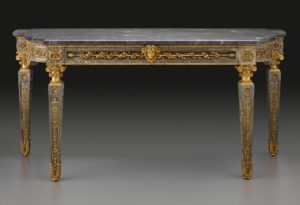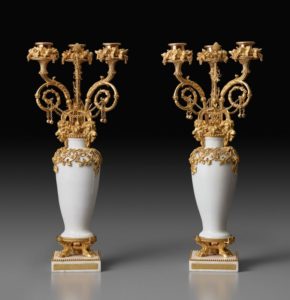The Artistry of Pierre Gouthière
EVENTS > NYC ANTIQUES WEEKEND
In Review: NYC Antiques Weekend 2017
The aura of glittering pomp surrounding the Chateau de Versailles in the last decades of the ancien régime owes much to the decadent reputation of the French monarchs, who leaned heavily on the talents and creativity of architects and artisans to maintain a potent image of power and wealth. This past winter, one such craftsman received well-deserved attention in the form of a special exhibition at the Frick Collection, “Pierre Gouthière: Virtuoso Gilder at the French Court.”
Participants in the Trust’s annual New York Antiques Weekend were treated to a special tour of the show by Frick Curatorial Assistant Geoffrey Ripert. This exhibit was the first to focus on Gouthière (1732–1813), a master chaser and gilder who worked for Louis XV and Louis XVI. Gouthière was not only revered in his own lifetime but also by subsequent generations who admired and eagerly sought out his beautiful work.
Charlotte Vignon, Curator of Decorative Arts at the Frick, drew inspiration for the show from the museum’s remarkable blue marble and gilt-bronze table commissioned for the Duchess of Mazarin. Her jewel-box exhibition brought together two dozen pieces from public and private collections in France and the United States.
The show and accompanying catalogue shed new light on Gouthière’s production, life, and workshop through objects firmly attributed to him, including clocks, sconces, and mounts for Chinese porcelain and hardstone vases. Gouthière’s primary focus was applied ornament rather than complete works of art. As such, he collaborated with great architects and sculptors of the period, such as François-Joseph Bélanger, Claude-Nicolas Ledoux, Louis-Simon Boizot, and others.
In 1767 Gouthière began working for the Menus-Plaisirs du Roi, an institution responsible for providing the king’s personal effects, thus starting a long career at the service of the French court. His works were so admired by Louis XVI and Marie Antoinette that in addition to commissioning objects directly they also purchased them second-hand at auction.
An important byproduct of an exhibition limited to works documented to Gouthière with certainty is the creation of a body of data by which additional attributions will be confirmed. As part of the project, conservators undertook a technical study of Gouthière’s bronze and gilding techniques. This data provides the basis for a much-needed reevaluation of the attribution and chronology of Gouthière’s oeuvre and elucidates his workshop practices.
Unfortunately, Gouthière’s wasteful expenditures and a series of financial setbacks—a huge uncollectable sum owed to him by Madame Du Barry and the death of two of his most important clients, the Duke of Aumont and Duchess of Mazarin, in the early 1780s—forced him to declare bankruptcy in 1787. A sad ending to the stellar career of one of the 18th century’s most talented craftsmen.



